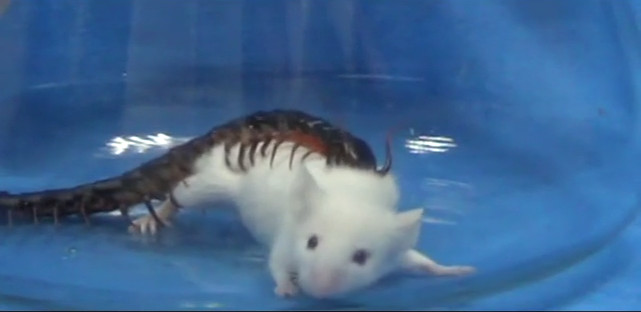Poisonous poison knocked out large mice 15 times in half a minute
The yellow-headed centipede uses a powerful weapon as a powerful venom to kill mice 15 times bigger in just 30 seconds.
Scientists learn the deadly venom of the yellow-headed centipede in a new study published in the journal Proceedings of the National Academy of Sciences, Newsweek, reported yesterday.
Many new types of venom have been discovered thanks to techniques that allow for very small venom analysis, according to Mandë Holford, a chemist who specializes in snail venom at Hunter University and the Center for Advanced Study at New York University , who did not participate in the study. But the team not only detected venom but also found a treatment.
Golden-headed centipedes can turn this species into the most effective poisonous predator, said study co-author Shilong Yang from Kunming Institute of Zoology in China. The centipede can kill white mice 15 times bigger than it does in 30 seconds.
Yellow-headed centipedes distributed in China and Hawaii, also bite people, sometimes lethal. Therefore, the team wants to find out what makes their venom so dangerous. They identified a new poison and named it Ssm Spooky Toxin. According to Yang and his colleagues, this poison is not the same as any other poison that scientists have known.

Golden-headed centipedes can turn this species into the most effective poisonous predator.
Next, the researchers discovered the poison Ssm Spooky Toxin blocked a series of cellular structures called KCNQ channels , used to transmit salt into and out of cells. As a result, the blood vessels in the target body of the centipede shrink, sometimes strong enough to cause death. In small animals, yellow-headed centipedes can bite into the head, toxins in the brain can also lead to seizures.
Yang's group thinks that a seizure medication called retigabine can open up KCNQ channels can help deal with venom and initial test results are very promising. In the next step, they wanted to test the drug in unfortunate victims of bites.
- Animals that steal the poison of another species
- Big horns are horrifying rat mice in less than a minute
- The rule of '3 in half a minute, 3 in half an hour' to prevent sudden death
- Snakes died in a death battle with poisonous centipedes
- Fear of the poisonous poisonous tree of Vietnam in 7 steps
- Japan caught poisonous fish 50 times more than puffer fish
- The mole rats eat the mouse rat manure to get instructions for raising children
- Poisonous spider encased mice in silk cocoons to eat gradually
- Poisonous spider spider
- Identify deadly poisonous mushrooms in Vietnam
- Admire the flower of the
- Frogs, snakes, lizards ... have extremely dangerous venom but why don't they harm themselves?
 Animal 'suffering' after hibernation
Animal 'suffering' after hibernation Why do goats climb well?
Why do goats climb well? Scientists were surprised to see chimpanzees eating turtles
Scientists were surprised to see chimpanzees eating turtles Giant catfish died deadly due to drought in Thailand
Giant catfish died deadly due to drought in Thailand